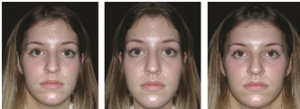All Faces are Asymmetric – Recognizing and Treating Facial Asymmetry
All faces are asymmetric. Many are so insignificant to be never noticed, while those at the other end of the spectrum are deforming. Fortunately, asymmetries are usually subtle but, with sufficient scrutiny, detectable. Their recognition preoperatively is important to both the surgeon and the patient. The patient’s asymmetry should be pointed out during the preoperative consultation so that the patient can anticipate asymmetry in the post-operative result. A useful tool in recognizing subtle asymmetry in a “normal face†is to manipulate a frontal photograph to create three separate images as shown below. The image on the left is a frontal view of a woman presenting for rhinoplasty. The center image is a composite created by joining the right side of face with its mirror image. The image on the right is a composite created by joining the left side of the face with its mirror image.
As asymmetries become more severe, it is important to recognize that they are more complex than relative skeletal deficiencies or excesses. Rather, they reflect three dimensional differences that are most easily conceptualized as twists of the facial skeleton.
Some asymmetries can be managed, by various soft tissue manipulations. Others require manipulation of the underlying skeleton. Below is a picture with significant lower jaw asymmetry after orthognathic surgery. To the right is a three dimensional CT scan showing the responsible anatomy.
Below is the post-operative appearance after the jaw asymmetry was corrected with implants designed on CT data.
For surgical planning and for reasonable expectations, both the patient and surgeon should be aware of facial asymmetry. Both sophisticated soft tissue and skeletal manipulations are available to minimize the visual impact on facial appearance.




Leave Comments
You must be logged in to post a comment.